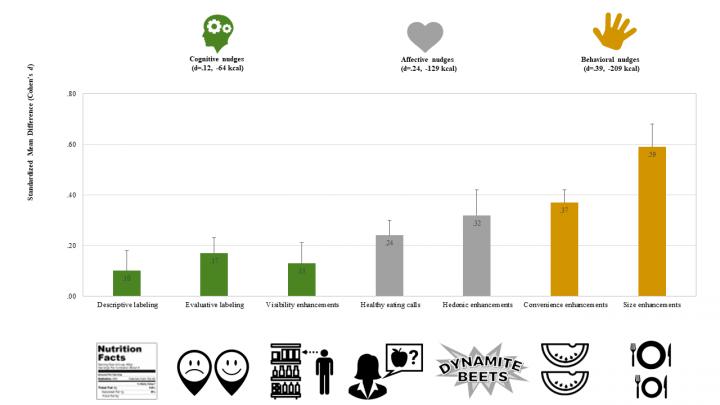Study of real-life experiments from many disciplines shows the most effective ways restaurants and grocery stores can influence healthy eating

Credit: Pierre Chandon
Fontainebleau (France), Singapore, Abu Dhabi, 9 July 2019: Behavioural nudges have emerged as the best way to improve healthy eating, according to a new paper by Pierre Chandon, Professor of Marketing at INSEAD, and Romain Cadario, Assistant Professor of Marketing at IÉSEG School of Management.
Ever since Richard Thaler won the Nobel Prize in Economics, “nudge” has been front and centre in the interest of researchers and policy makers. A simple definition of nudge is an intervention that attempts to influence behaviours without using economic incentives and while preserving freedom of choice.
In a meta-analysis of real-life experiments drawn from food science, nutrition, health economics, marketing and psychology, the authors find that behavioural nudges – facilitating action rather than providing knowledge or inducing feelings – can reduce daily energy intake by up to 209 kcal, the same number of calories as in 21 cubes of sugar.
“Just changing the amount of food on a plate or the location of the food – without necessarily educating people about nutrition content or convincing them that they should eat healthily – is the most effective intervention because you don’t need to rely on changing people’s beliefs or their goals,” said Chandon. “There is tremendous potential to help people to eat better.”
Seven ways restaurants and grocery stores can nudge food choices
In “Which Healthy Eating Nudges Work Best? A Meta-Analysis of Field Experiments” published in Marketing Science, Chandon and Cadario examined 299 results from 96 real-life field experiments. Their analysis was directly funded by INSEAD and IÉSEG.
The study identified seven different types of nudges and classified them into three broad categories, depending on how they worked: cognitive, affective and behavioural. Cognitive nudges provide information, such as nutrition counts or make healthy options more visible on the shelf or on the menu. Affective nudges seek to influence how people feel, without necessarily changing what they know, for example by touting the taste of the food, not its healthiness. Behavioural nudges try to directly change behaviours without necessarily changing what people think or what they want, for example by changing the amount of food on the plate or by making healthier foods easier to select and consume.
Table 1 shows the full list of nudges, with examples.
Which healthy eating nudges work best?
After the experiments were categorised, the professors collated the data and measured the effectiveness of each type of nudge using the standardised mean difference (also known as Cohen’s d). By standardising the mean differences, we are able to compare the effectiveness of experiments using various units of measurements. To get a more intuitive grasp of nudge effectiveness, we computed the daily energy equivalent by multiplying the Cohen’s d value and the standard deviation in daily energy intake for an adult (537 kcal).
Considering all healthy food nudge experiments as a whole, the standardised mean difference or d is only 0.23, which is not very impactful. By separating the experiment results into cognitive, affective and behavioural groups, it is clear that some nudges are better than others.
Figure 1: The effectiveness of seven nudge types
Cognitive nudges provide information. Information on its own was not as successful a nudge as providing context to the information or as simply making healthier options more visible. The expected daily calorie reduction for cognitive nudges was about 64 kcal, or six sugar cubes worth of calories.
In comparison, affective nudges had an expected daily reduction of 129 kcal, around the same as 13 cubes of sugar. Behavioural nudges led to a more substantial change in calorie intake when compared to cognitive and affective nudges, the authors found. On average, they could reduce daily calorie intake by 209 kcal or 21 cubes of sugar.
Designing the best nudge
In addition to classifying and quantifying the effects of nudge experiments the researchers also compared other facets of the experiments – those in grocery stores vs. cafeterias; adults vs. children studied; experiments in the U.S. vs. those outside; nudges that promoted healthy choices vs. those that discouraged unhealthy choices; and food consumption vs. selection.
“The strength of our meta-analysis is not only to categorize interventions and measure their effectiveness. Our results are also robust when controlling for various population and study characteristics such as location, respondents’ age groups, study design or behavioural outcomes” Cadario said. It is important to control for these factors because they can be confounded with the type of nudge.
Cadario and Chandon found that the effect sizes for U.S. experiments were 47% greater there than the ones conducted in other countries. This could be for several reasons: larger portions, a higher proportion of overweight Americans, or perhaps because they tend to focus less on the experience of eating and more on the health effects.
They also found that nudge experiments were most successful at reducing unhealthy eating rather than increasing healthy eating or reducing total eating.
Overall, the authors found that the best nudge experiment scenario for healthy eating outcomes was behaviourally oriented, focusing on unhealthy food consumption in an onsite cafeteria frequented by adults in the U.S which produced an effect size 4 ½ times larger than the typical scenario.
Marketing and healthy choices
Cognitive interventions have merit from an ethical point of view. Information is of value itself. However, providing information about calories or nutrition without a context did not have much of an impact on the subjects’ consumption.
“Change the shopping environment, the way information is displayed, the way products are displayed to influence customers to go in a particular direction. This is already happening, but the placement of healthy choices at the beginning or the end of the cafeteria line or the size of plates, glasses or portions can make an even bigger difference,” Chandon explained.
Business schools like INSEAD and IÉSEG are at the centre of research on eating behaviour, at the intersection of many academic disciplines and the business world. Business scholars are informed by medicine and public health researchers and go on to present results to food companies, retailers and others on the front lines of food service in order to help them transition to a healthier and more sustainable business.
“Marketing is not about selling more. Marketing is about creating value for the firm by creating value for the customers. By giving people not just large portions at a low price, but quality, food companies can help their customers eat better, which is an important goal for many of them” said Chandon.
###
About INSEAD, The Business School for the World
As one of the world’s leading and largest graduate business schools, INSEAD brings together people, cultures and ideas to develop responsible leaders who transform business and society. Our research, teaching and partnerships reflect this global perspective and cultural diversity.
With campuses in Europe (France), Asia (Singapore) and the Middle East (Abu Dhabi), INSEAD’s business education and research spans three continents. Our 155 renowned Faculty members from 40 countries inspire more than 1,300 degree participants annually in our MBA, Executive MBA, Specialised Master’s degrees (Master in Finance, Executive Master in Change) and PhD programmes. In addition, more than 12,000 executives participate in INSEAD Executive Education programmes each year.
INSEAD continues to conduct cutting-edge research and innovate across all our programmes. We provide business leaders with the knowledge and awareness to operate anywhere. These core values drive academic excellence and serve the global community as The Business School for the World.
For more information, visit http://www.
INSEAD contacts for press:
Chris Howells
Tel: +65 6799 5490
Email: [email protected]
Aileen Huang (Asia)
Tel: +65 6799 5552
Email: [email protected]
Cheryl Ng (Asia)
Tel: +65 6407 7234
Email: [email protected]
Ilan Goren (Europe)
Tel: +33 678042577
Email: [email protected]
Media Contact
Chris Howells
[email protected]
Related Journal Article
http://dx.




